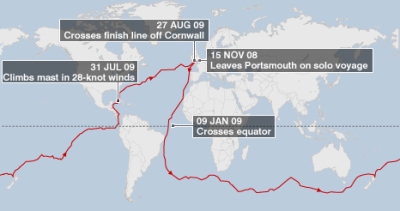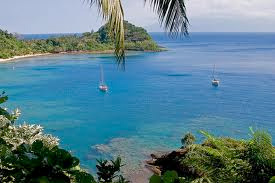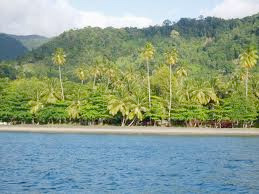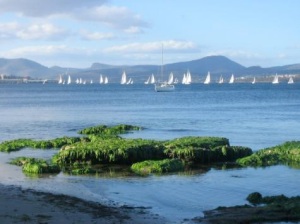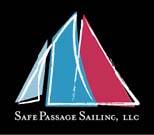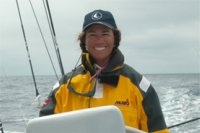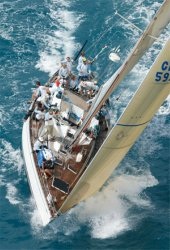SHE DID IT! LAURA DEKKER COMPLETES SOLO CIRCUMNAVIGATION!
It seems like the past few years were filled with great sailing feats by young sailors. Now the youngest has come home safely after voyaging 18,265 nm. On January 23, Dutchwoman Laura Dekker became the new youngest solo circumnavigator, reducing Australian Jessica Watson’s voyage by six-months.

Laura Dekker, 16, is reunited with her mother, sister and father on her arrival in St. Martin after a 361-day circumnavigation. Photo lauradekker.nl.
Having covered most of these attempts while writing the Cruising Compass for Blue Water Sailing Magazine, I became a champion of sorts, in hopes of forwarding their causes, and in some way, helping to broadcast their amazing feats to the non-adventure sailing world.
Some of you may recall that Dekker ran into more than just rough seas even before she set off on her attempt at circumnavigating the planet. She had intended to start her adventure at age 13, but Dutch authorities tried to block Dekker’s trip, arguing she was too young to risk her life, while school officials said she should be in a classroom.
“The Dutch government was not kind to me,” Laura Dekker wrote on her blog last week. “It was never my intention to be the center of world news. From the moment my plans became public, Youth Care and other government organisations tried to stop me. During the first court case, in August 2009 they asked the judge to take me away from my father and to lock me up in a secure clinic. Now, after sailing around the world, with difficult port approaches, storms, dangerous reefs, and the full responsibility of keeping myself and Guppy safe, I feel that the nightmares the Dutch government organisations put me through, were totally unfair. I am seriously thinking about not returning to the Netherlands. Of course I will discuss this with my parents.”
Unlike other young sailors who recently crossed the globe, Dekker repeatedly anchored at ports along the way to sleep, study and repair her 38-ft Jeanneau Gin Fizz Guppy. The teenager covered more than 27,000 nautical miles on a trip with stops at ports including the Canary Islands, Panama, the Galapagos Islands, Tonga, Fiji, Bora Bora, Australia, South Africa and finally St Maarten, from where she set out on 20 January 2011. Now, though she claims to be the youngest sailor to complete a round-the-world voyage, Guinness World Records and the World Sailing Speed Record Council would not verify the claim, saying they no longer recognize records for youngest sailors in order to discourage dangerous attempts.
Authorities in The Netherlands were quick to commend Dekker on her bravery, skill and perseverance, but insisted they had been correct to intervene.
“If Laura had drowned, we would be accused of not having done enough to protect her,” said an official from the Bureau of Youth. She added that it’s possible that Dekker made it around because they required her to sail a larger, more robust and better-equipped boat.
Dekker launched her trip two months after Abby Sunderland, a 16-year-old American sailor, was rescued in the Indian Ocean during a similar attempt. Australian teen Jessica Watson set off Oct. 18, 2009 from Sydney, Australia, in Ella’s Pink Lady, her Sparkman & Stephens 34. She rounded Cape Horn Jan. 13, 2010 and returned to Sydney on 15 May 2010. Watson completed a 210-day solo voyage just three days before her 17th birthday.
Mike Perham, also held the title of youngest person to sail solo around the world. He took nine months to circumnavigate the Globe in 2009 at age 17 on board the Open 50 racing yacht Totallymoney.com.
Though it is Jesse Martin, of Australia, who still holds the record, recognized by Guinness World Records as the youngest person to circumnavigate the globe, sailing solo, non-stop and unsupported, at age 18 years 104 days when he set off from Melbourne on December 8, 1998, taking 327 days 12hrs 52 mins.
“A true circumnavigation of the Earth must: start and finish at the same point, traveling in one general direction, reach two antipodes, cross the equator, cross all longitudes, cover a minimum of 40,000km..”
(21,600 NM, the circumference of the world at the equator.
– Explorers Web AdventureStats, 2007….
Dekker says her circumnavigation was about the voyage and she isn’t concerned about formal recognition. Neither is Hachette Book Group, which has already offered Watson a book deal, saying it will publish the blog entries she has written throughout her trip “as soon as possible after her return,” according to media reports.
“I think readjusting to life on land, keeping up with some of the exciting things planned for me, finishing my book and documentary, getting my driver’s license, and finishing school will be more than enough to keep me busy,” says Watson in her May 4 blog.
I’d like to offer a big “Congrats” to Laura. Our virtual “hats off” for an amazing feat. Well done! You go girl!



